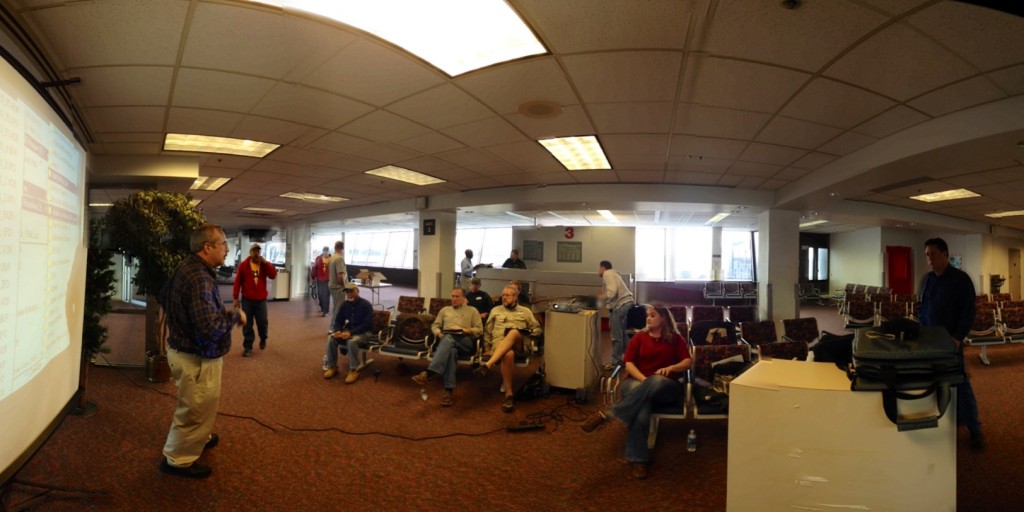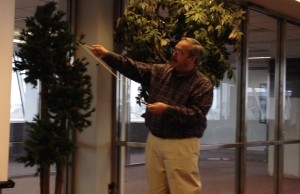You’d have to have worked pretty hard this Sunday to beat my Sunday. I kicked it off with the FAST formation ground school at Detroit City Airport (KDET).
The Formation and Safety Team (FAST) is a worldwide educational organization dedicated to teaching safe formation flying. FAST is made up of 16 signatory organizations whose mission is to support education in the restoration, maintenance and flight of their members’ aircraft. FAST does not itself promulgate standards that reach into the cockpits of the individual formation ships. Signatory organizations take the core FAST materials and customize them to their aircraft-specific missions.
This specific session was hosted by the Tuskegee Airmen Glider Club, a club that operates three of the remaining nine Schweizer SGM 2-37 motorgliders, all surplus from the USAF Academy since 2003. The club wants to be able to fly the gliders in formation in waivered airspace at airshows, which requires that the pilots have the appropriate FAST cards. The ground school is the beginning of the process, so they hosted one.
I went along because a club member invited me. And because I’ve been in several formation flights (a two-ship with the AeroShell Team and several three- and four-ships with The Hoppers) and I’ve begun to understand that formation flying is nowhere near as easy as it looks. It also fits in with the theme of this season, which is turning out to be a series of experiences embedded in various airshow roles. I was pyro crew for Mark Sorenson and Tiger Airshows a few weeks ago at TICO and I might end up doing a team narrator gig at one or more shows this summer for one or more performers.
The ground school is taken up mostly with the organization of the FAST system, the requirements for a FAST card, and substantive information about formation flying. It’s broken up into formation fundamentals, two-ship formations, two-ship rejoins, extended trail and tail chase, four-ship formation, operating limitations, and abnormal procedures. We used The Formation Pilot’s Knowledge Guide in a version customized by the Red Star Pilots’ Association (an organization dedicated to flying Eastern Bloc warbirds).
There’s an amazing amount of information that you need to know. Just operating the aircraft in formation takes almost all of your concentration. You sure don’t want to have to think about what hand signals mean when you’re trying to stay on somebody’s wing. So you need to have all of the procedural stuff down cold. Like hand signals, NORDO procedures, landing procedures, formation changes, and similar matters. It’s hard enough flying where you’re supposed to fly. You can’t spare any bandwidth for trying to figure out where you’re supposed to be in the first place or what’s coming next. You just have to know it cold.
You have to know the vocabulary of formation flight. If someone talks about being acute or sucked, you need to understand what’s being said. You also have to know the conventions. For example, turns in echelon are all done at the same altitude. The formation itself doesn’t bank. Only the airplanes do. (Think about how badly you’re going to surprise the other guys in the formation if everybody else banks in a level turn and you, in the three-ship. go high and wide to preserve the echelon shape. Not good. Lead will be impolite during the debriefing.)
Dan Schiffer, a T-6 driver from East Lansing, Michigan, taught the ground school. Dan has more time in warbirds than I have in my car. He taught the class with gritty pragmatism. In the shot above, he’s showing aspect lines and the geometry of a rejoin. He actually has two scale aircraft on sticks that are joined by string on fishing weights to show the lines even when the aircraft are at different distances from each other.
Dan was injured in an accident on September 17, 2011 near Grand Haven, Michigan when the engine of the T-6 that he was flying quit shortly after takeoff. There’s video of the accident here. (Don’t actually read the text of the news story. It’s horrible. Avert your eyes.) According to the NTSB preliminary report, “[t]he airplane was the fourth airplane in a flight of five to depart 5N7. The airplane lost power during its takeoff, impacted a tree on the left side of the runway, and subsequently impacted terrain. The pilot was taken to a hospital for his injuries.” Dan has always worn all available safety gear, including a Nomex flight suit, helmet, and thick-soled shoes. His gear played a major role in limiting his injuries in the crash and he spent no small amount of time talking about the importance of safety gear.
I think he’s pretty well talked me into getting a helmet. I can imagine the canopy bar of the Pitts coming at my face in a bailout situation and having a face shield and some Kevlar around my melon seems like a good idea against that eventuality. Plus, I’d get to look like Billy Werth.
I have a take-home test that I need to get through over the next few days and then get it to Dan for grading. That gets me my FAST ground school certificate. So, in the unlikely event that I ever line up an opportunity to fly 10 hours of formation with a FAST instructor in the trunk, I’ll have the basic knowledge necessary to really begin learning.
After the ground school broke up, I got up with John Harte in one of the motorgliders. 1.4 hours, including flying over my house up in Bloomfield Hills for only the second time, then 12 takeoffs and landings, including four practice emergency returns to the runway. That flight (er, in glider parlance, those flights) are worthy of a separate post and I’ll write it shortly.




Speak Your Mind